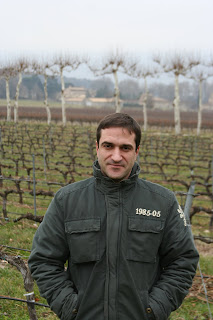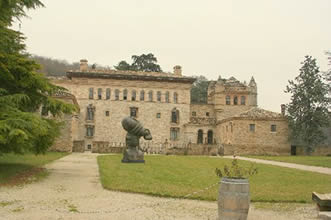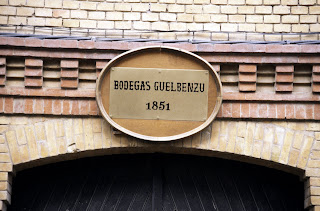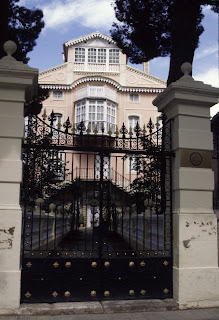|
 |
| Javier Colio, Winemaker at Otazu |
Indeed, except for their Sotavento blend that uses 80% tempranillo–the rest cabernet sauvignon and merlot–and is the lowest in alcohol at 12.7% (see, it can be done) and oak (five months), Otazu’s other red wines are very Bordeaux/-like blends (except for the 5% - 20% addition of tempranillo). However, on the palate, they come across as supercharged Bordeaux, if not Napa Valley like (the natural acidity in this region prevents that caricature). Palacio de Otazu Dimensión (50% merlot, 30% cabernet sauvignon, 20% tempranillo) tips the scales at 14.4% alcohol; Berquera (70% merlot, 20% cabernet sauvignon, 10% tempranillo) weighs in at 14.19%; and the top of the line (in a bottle of hernia-inducing weight) Altar, their big Cab (90% cabernet, 5% merlot, 5% tempranillo) just squeaks in over the magic 14.5% bar by a whisker 14.51%, says the label, which being
 |
| Señorío de Otazu |
so precise may make Otazu one of the few wineries not lying in print about the actual alcohol content of their wines. Otazu also makes a good, mercifully un-oaked night harvested Chardonnay (13.8%) and the obligatory, butterscotch-laced, barrel fermented (in new French Allier, light toast; also around 13.8%) Chardonnay that spends a year in oak.
Somewhere in the back of his mind, I am sure that new generation jefe Javier Bañales, Director Gerente at Otazu–who with his enologist Javier Colio, has a big hand in the winemaking process–knows that he potentially has one of the greatest estates in Spain, perhaps rivaling Chivite's Arinzano. For one thing, the Atlantic-influenced northern climate here puts it near the limits of cultivation, as most of the greatest wine regions of the world used to be (at least before global warming), but the sierras, the annual rainfall (about 600mm), the fogs from the Arga and the stands of trees all have a beneficent influence on Otazu’s unique micro-climate (which Bañales says also has a "buena influencia Mediterránea"), which points to the potential for producing some of most elegant, Bordeaux-like wines in Spain. They may also have the climate for producing Burgundy-like wines. Anyone who has ever spent a Fiesta de San Fermín in Pamplona in July can attest to the Burgundian-like fickleness of the climate. (Can someone tell me why the D.O. Navarra never approved the planting of pinot noir here?).
 |
| Otazu |
Otazu has it all, except in this writer's opinion, the will to back off from making wines that the "market is asking for" and let the grapes, climate and soil lead them to the Grand Cru Classé that this superb estate has all the necessary elements to become. Although there are signs that these wines are evolving in that direction, to this palate, there is still far too much new oak evident, too much power for power's sake and not enough viticultural and winemaking restraint to allow these wines to achieve true greatness at the level at which Bordeaux used to be reknowned.
Javier Bañales and many other producers in Spain have one Hell of a road ahead of them, one with even more potholes in the severe wine crisis that is coming (the weak dollar, soaring petrol prices, home foreclosures and all the other economic calamities that the Bush administration’s insane robber oil baron policies have foisted upon us, all of which will make expensive, overblown wine a commodity way down on the scale of luxuries, let alone necessities). Once Parkerization established a premium on overripe fruit, overblown alcohol levels and new oak as the criteria to be prized over balance, elegance, grace, charm, style and, above all, the sense of terroir (place, soil, altitude, climate), the latter qualities have taken a backseat at many wineries, not just Otazu.
Market forces and wine reviewers–including, and especially, those in Madrid, who seem to think that Spain has to exhibit El Cid-like balls when it comes to wine–continue in lock-step with the Parkerista crowd (Spain this year gave their highest national wine prize, the Premio Nacional de Gastronómia to Dr. Jay Miller, Parker's Spain beat reporter, this after less than two years of Spanish wine reviews. Why? Because he gave 100 pts. each to five monster ball wines, which points out how commercial the whole thing has become.) Money, power, wretched excess and winemaking through chemistry, technological manipulation and the use of irrigation to attain overripe fruit, all rule over knowledge, real style, authentic reflections of terrior and taste in today's world wine market. (If you want to understand the whole process and just how ridiculous (and horrendous) the wine business has become, a must read is Alice Feiring’s new book, The Battle for Wine and Love or How I Saved the World from Parkerization [Harcourt, Inc., New York], which explains the whole mess in can’t-stop-turning-the-page detail.)
 |
| Guelbenzu, a family winery in Cascante, was founded in 1851. |
In far southern Navarra, Guelbenzu (www.guelbenzu.es), a family winery dating to 1851, lobbied several years ago for the formation of the Vinos de la Tierra la Ribera del Quieles (from the Quieles River valley), which straddles the Navarra-Aragón border and withdrew from the Navarra DO. The subsequent approval of V.T. status gave Guelbenzu the advantage of sourcing grapes from both provinces within this unique microclimate. Bearing its distinctive triangle-within-a-circle label design, Guelbezu's wines from the Navarra vineyards include Azul (Blue), a tempranillo-merlot-cabernet- blend; EVO, which features each harvest's finest cabernet sauvignon; and Lautus, the winery’s top, ageworthy wine, which features a similar blend as Azul, but with the specially selected grapes and the addition of garnacha.
 |
| The Guelbenzu family home stands next to their
Cascante (Navarra) winery, founded in 1851. |
Mayor de Ondarre, Barón de Ley and Rioja Vega are the standard bearers for the legally designated Rioja-producing section of Navarra, generally producing wines that are more in the full-flavored in the meaty, robust, but still well-balanced style generally associated with the wines of La Rioja Baja.
Navarra wines from the recommended producers offer some excellent, often reasonably priced drinking and some are a welcome relief from the palate assaulting wines from all over the world that are far too often encountered these days. What is certain is that there is growing evidence–in magazine articles, on weblogs and from scores of conversations–from both professionals (many wine writers, young sommeliers and even the winemakers themselves) and consumers that a wave against the excesses of the highly concentrated, overripe, alcoholic, heavily oaked wines of the past couple of decades is growing into a tsunamai, despite the fact that many producers (not just in Spain, but in Napa, Australia and elsewhere) have spent years trying to paint these Parkerista-fattened hogs as thoroughbred race horses. In fact, to the point where they sell "concentration," which French nouvelle cuisine decried years ago in doing away with overly rich reduction sauces as a quality standard for fine cooking, as a virtue in wine, when in fact such concentrated, dense wines are like putting a sumo wrestler as a jockey in the Derby in which the heaviest, slowest horse wins.
Navarra, with its temperate climate-driven versatility is a place particularly well suited to produce flavorful modern wines with balance and restraint across the spectrum. As winemakers and consumers open their eyes (and palates) and seek the antidote to the excesses of many of today’s wines, they would do well to consider some of the wines from the recommended Navarra producers. They may soon find themselves lifting a glass of surprisingly elegant chardonnay, supernal garnacha rosado, fine well-balanced vino tinto or luscious moscatel dessert wine, taking a sip and exclaiming, "Viva Navarra!"
The End
About the author
 Gerry Dawes was awarded Spain's prestigious Premio Nacional de Gastronomía (National Gastronomy Award) in 2003. He writes and speaks frequently on Spanish wine and gastronomy and leads gastronomy, wine and cultural tours to Spain. He was a finalist for the 2001 James Beard Foundation's Journalism Award for Best Magazine Writing on Wine. Gerry Dawes was awarded Spain's prestigious Premio Nacional de Gastronomía (National Gastronomy Award) in 2003. He writes and speaks frequently on Spanish wine and gastronomy and leads gastronomy, wine and cultural tours to Spain. He was a finalist for the 2001 James Beard Foundation's Journalism Award for Best Magazine Writing on Wine.
Mr. Dawes is currently working on a reality television series on wine, gastronomy, culture and travel in Spain.
Gerry Dawes can be reached at gerrydawes@aol.com Alternate e-mails (use only if your e-mail to AOL is rejected): gerrydawes@optonline.net or gerrydawes@hotmail.com

Page 1 2 3
|